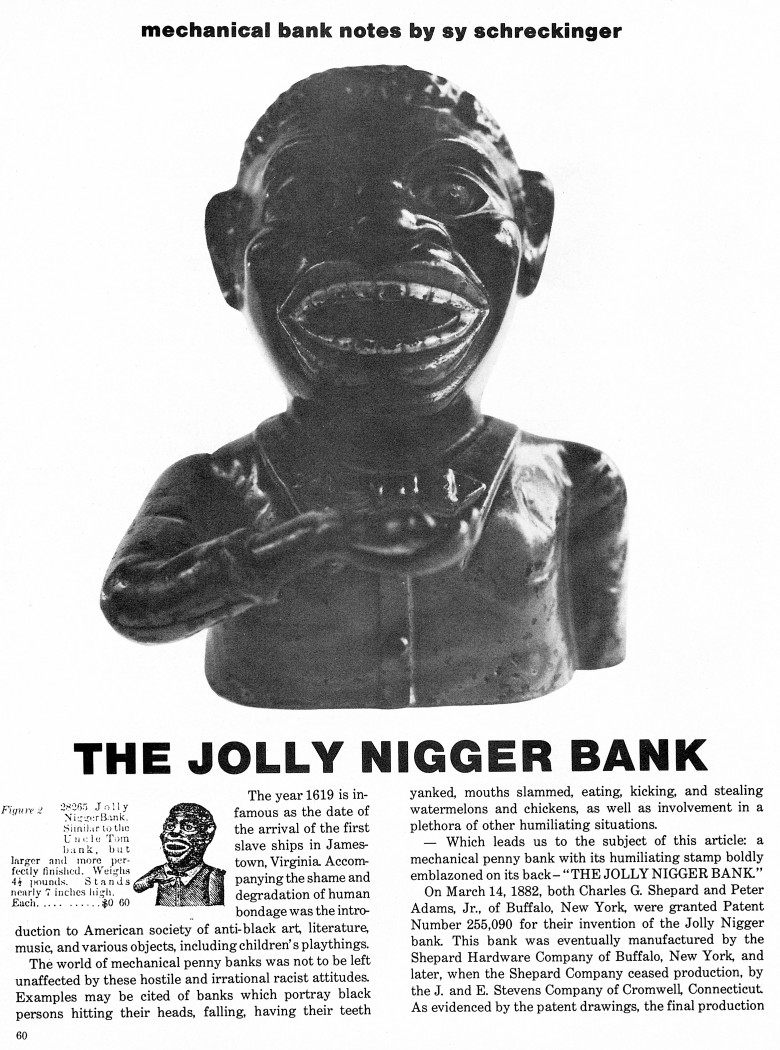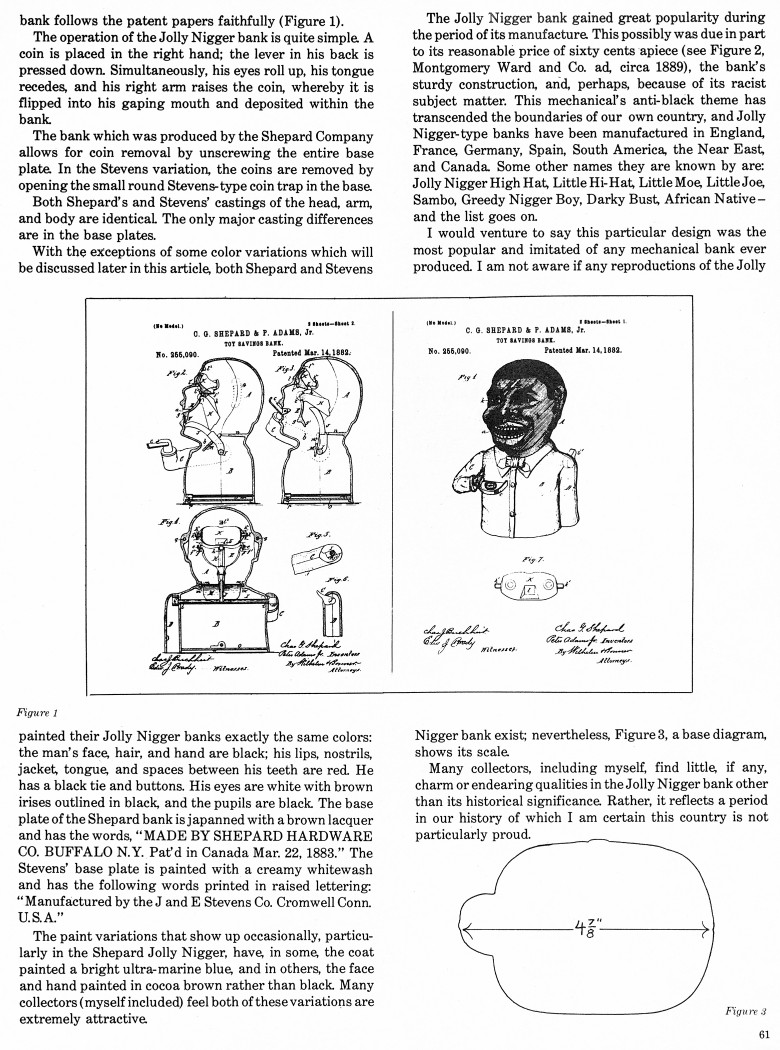|
The Jolly Nigger Bank
by Sy Schreckinger – ANTIQUE TOY WORLD Magazine – December,
1983
The year 1619 is infamous as the (date of the
arrival of the first slave ships in Jamestown, Virginia. Accompanying the
shame and degradation of human bondage was the introduction to American
society of anti-black art literature, music, and various objects,
including children's playthings.
The world of mechanical penny banks was not to be left unaffected by
these hostile and irrational racist attitudes. Examples may be cited of
banks which portray black persons hitting their heads, falling, having
their teeth yanked, mouths slammed, eating, kicking, and stealing
watermelons and chickens, as well as involvement in a plethora of other
humiliating situations.
— Which leads us to the subject of this article: a mechanical penny
bank with its humiliating stamp boldly emblazoned on its back – "THE JOLLY
NIGGER BANK"
On March 14, 1882, both Charles G. Shepard and Peter Adams, Jr., of
Buffalo, New York were granted Patent Number
255,090 for their invention
of the Jolly Nigger bank. This bank was eventually manufactured by the
Shepard Hardware Company of Buffalo, New York and later, when the Shepard
Company ceased production, by the J. and E. Stevens Company of Cromwell.
Connecticut. As evidenced by the patent drawings, the final production
bank follows the patent papers faithfully (Figure 1).
The operation of the Jolly Nigger bank is quite simple. A coin is
placed in the right hand; the lever in his back is pressed down.
Simultaneously, his eyes roll up, his tongue recedes, and his right arm
raises the coin, whereby it is flipped into his gaping mouth and deposited
within the bank.
The bank which was produced by the Shepard Company allows for coin
removal by unscrewing the entire base plate. In the Stevens variation, the
coins are removed by opening the small round Stevens-type coin trap in the
base.
Both Shepard's and Stevens' castings of the head, arm, and body are
identical. The only major casting differences are in the base plates.
With the exceptions of some color variations which will be discussed
later in this article, both Shepard and Stevens painted their Jolly Nigger
banks exactly the same colors: the man's face, hair, and hand are black;
his lips, nostrils, jacket, tongue, and spaces between his teeth are red.
He has a black tie and buttons. His eyes are white with brown irises
outlined in black and the pupils are black. The base plate of the Shepard
bank is japanned with a brown lacquer and has the words, "MADE BY SHEPARD
HARDWARE CO. BUFFALO N.Y. Pat'd in Canada Mar. 22, 1883." The Stevens'
base plate is painted with a creamy whitewash and has the following words
printed in raised lettering "Manufactured by the J and E Stevens Co.
Cromwell Conn. U.S.A."
The paint variations that show up occasionally, particularly in the
Shepard Jolly Nigger, have, in some, the coat painted a bright ultra-marine blue, and in others, the face and hand painted in cocoa brown
rather than black. Many collectors (myself included) feel both of these
variations are extremely attractive.
The Jolly Nigger bank gained great popularity during the period of
its manufacture This possibly was due in part to its reasonable price of
sixty cents apiece (see Figure 2, Montgomery Ward and Co. ad. circa 1889),
the bank's sturdy construction, and, perhaps, because of its racist
subject matter. This mechanical's anti-black theme has transcended the
boundaries of our own country, and Jolly Nigger-type banks have been
manufactured in England, France, Germany, Spain, South America, the Near
East, and Canada. Some other names they are known by are: Jolly Nigger
High Hat, Little Hi-Hat, Little Moe Little Joe, Sambo, Greedy Nigger Boy,
Darky Bust, African Native – and the list goes on.
I would venture to say this particular design was the most popular
and imitated of any mechanical bank ever produced. I am not aware if any
reproductions of the Jolly Nigger bank exist; nevertheless, Figure 3, a
base diagram, shows its scale.
Many collectors, including myself, find little, if any, charm or
endearing qualities in the Jolly Nigger bank other than its historical
significance. Rather, it reflects a period in our history of which I am
certain this country is not particularly proud.
|


